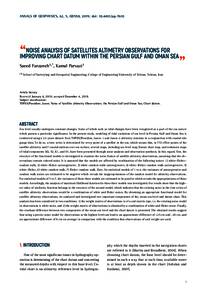Document
Noise analysis of satellites altimetry observations for improving chart datum within the Persian Gulf and Oman Sea.
Identifier
DOI: 10.4401/ag-7610
Source
Annals of Geophysics. v. 62, 5, GD558
Contributors
Parvazi, Kamal., Author
Country
Italy
Publisher
Editrice Compositori s.r.l.
Gregorian
2019-01-01
Language
English
English abstract
Sea level usually undergoes constant changes. Some of which such as tidal changes have been recognized as a part of the sea nature which possess a particular significance. In the present study, modeling of tidal variations of sea level in Persian Gulf and Oman Sea is conducted using a 22−years dataset from TOPEX/Poseidon, Jason−1 and Jason−2 altimetry missions in a conjunction with coastal tide gauge data. To do so, a time series is determined for every point of a satellite in the sea, which means that, in 772 effect points of the satellite altimetry and 7 coastal stations over sea surface, several maps, including sea level map, Datum chart map, and codomain maps of tidal components M2, S2, K1, and O1, have been presented through noise analysis and observation synthesis. In this regard, first, the structure of the functional models is investigated to examine the noise feature of satellite altimetry observations, assuming that the ob− servations contain colored noise. It is assumed that the models are affected by combination of the following noises: 1) white−flicker− random walk, 2) white−flicker−autoregressive, 3) white−random walk−autoregressive, 4) white−flicker−random walk−autoregressive, 5) white−flicker, 6) white−random walk, 7) flicker−random walk. Here, for statistical models of 1 to 4, the variances of autoregressive and random walk noises are estimated to be negative which reveals the inappropriateness of the random model for altimetry observations. For statistical models of 5 to 7, the variances of these three models are estimated to be positive which reveals the appropriateness of these models. Accordingly, the analysis of maximum likelihood function for these three models was investigated. Our results show that the high− est value of similarity function belongs to the structure of the second model, which indicates that the existing noise in the time series of satellite altimetry observations would be a combination of white and flicker noises. By obtaining an appropriate functional model for satellite altimetry observations, we analyzed and investigated two important components of the, mean sea level and datum chart. This analysis has been considered in two conditions: 1) the weight matrix of observations is of a unit matrix type, i.e. the existing noise model in observations is white noise, and 2) the weight matrix of observations is obtained by a combination of white and flicker noise. Finally, the resultant difference between two components of the mean sea level and the chart datum is presented. The obtained results suggest that using a precise noise model for observations at the highest level can lead to an approximate difference of +25 cm and −20 cm, and an approximate difference of 8 cm on average in comparison with the condition that observations of unit weight are used.
ISSN
1593-5213
Category
Journal articles

